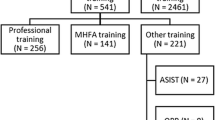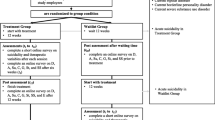Abstract
Purpose
Although trained volunteers are considered to be a valuable source of emotional first aid for individuals in crisis, there is a paucity of empirical evidence comparing them to lay individuals. The current study exploits a methodological opportunity engendered by an online support group in which both trained volunteers and lay individuals responded to the same distressful messages within the same naturally occurring setting.
Method
The two groups were compared on the basis of the types of strategies they employed in response to 111 suicidal messages retrieved from an online support group operated by the Israeli Association of Emotional First Aid (ERAN).
Results
Trained volunteers used a wider variety of strategies. They also employed more emotion-focused strategies and more therapeutic-like cognitive-focused strategies than the lay individuals. Self-disclosure was more prevalent among the responses of the lay individuals.
Conclusions
Trained volunteers constitute a valuable community source of suicide prevention. The implications of the findings regarding the provision of crisis intervention and suicide prevention via an online support groups are discussed.

Similar content being viewed by others
References
Heilig SM, Farberow NL, Litman RE, Shneidman ES (1968) The role of nonprofessional volunteers in a suicide prevention center. Community Ment Health J 4:267–295
Caplan G (1964) Principles of preventive psychiatry. Basic Books, New York
Compton MT, Thompson NJ, Kaslow NJ (2005) Social environment factors associated with suicide attempt among low-income African Americans: The protective role of family relationships and social support. Soc Psychiatry Psychiatr Epidemiol 40:175–185
Kidd S, Henrich CC, Brookmeyer KA, Davidson L, King RA, Shahar G (2006) The social context of adolescent suicide attempts: interactive effects of parent peer and school social relations. Suicide life-threat 36:386–393
Thomas HV, Crawford M, Meltzer H, Lewis G (2002) Thinking life is not worth living: a population survey of Great Britain. Soc Psychiatry Psychiatr Epidemiol 37:351–356
Knicherbocker DA, McGee RK (1973) Clinical effectiveness of nonprofessional and professional telephone workers in a crisis intervention center. In: Lester D, Brockop GW (eds) Crisis intervention and counseling by telephone. Charles C. Thomas, Springfield, pp 298–309
Hirsch S (1981) A critique of volunteer-staffed suicide prevention centers. Can J Psychiatr 26:406–410
O’Donnell J, George K (1977) The use of volunteers in a community mental health center emergency and reception service: a comparative study of professional and lay telephone counselors. Community Ment Health J 13:3–12
Truax C, Carkhuff R (1967) Towards a more effective counseling and psychotherapy. Adline, Chicago
Kalafat J (2002) Trained telephone counselors. In: Lester D, Brockop GW (eds) Crisis intervention and counseling by telephone. Charles C. Thomas, Springfield, pp 252–259
Barak A, Boniel-Nissim M, Suler J (2008) Fostering empowerment in online support groups. Comput Hum Behav 24:1867–1883
Hsiung RC (2000) The best of both worlds: an online self-help group hosted by a mental health professional. Cyber Psychol Behav 3:935–950
Barak A (2007) Emotional support and suicide prevention through the Internet: a field project study. Comput Hum Behav 23:971–984
Gilat I, Shahar G (2009) Suicide prevention by online support groups: an action theory-based model of emotional first aid. Arch Suicide Res 13:52–63
Gilat I, Shahar G (2007) Emotional first aid for a suicide crisis: comparison between telephonic hotline and internet. Psychiatry 70:12–18
Miller JK, Gergen JG (1998) Life on the line: the therapeutic potentials of computer-mediated conversation. J Marital Fam Ther 24:189–203
Barber JG, Blackman EK, Talbot C, Saebel J (2004) The themes expressed in suicide calls to a telephone help line. Soc Psychiatry Psychiatr Epidemiol 39:121–125
Diagle M, Mishara BL (1995) Intervention styles with suicidal callers at two suicide prevention centers. Suicide Life-Threat 25:261–274
Eichenberg C (2008) Internet message board for suicidal people: a typology of users. Cyber Psychol Behav 11:107–113
Gilat I, Tobin Y, Shahar G (2011) Offering support to suicidal participants in an online support group. Arch Suicide Res 15:195–206
Karlsruher AE (1974) The nonprofessional as psychotherapeutic agent. Am J Community Psychol 2:61–77
Yanay N, Shahar G (1998) Professional feelings as emotional labor. J Contemp Ethnogr 27:346–373
McGee RK, Jennings B (2002) Ascending to “lower levels”: the case for nonprofessional crisis workers. In: Lester D, Brockop GW (eds) Crisis intervention and counseling by telephone. Charles C. Thomas, Springfield, pp 231–241
King R, Nurcombe B, Leonard B, Hides L, Reid W (2003) Telephone counseling for adolescent suicide prevention: changes in suicidality and mental state from the beginning to end of a counseling session. Suicide Life-Threat 33:400–411
Gilat I, Latzer Y (2012) Emotional first aid in eating disorders: the unique role of hotlines and online services. In: Stein D, Latzer Y, Merik Y (eds) Treatment and special issues of eating disorders, Nova Science Publishers, New York (in press)
Kazdin AE, Stacey LB (2011) Rebooting psychotherapy research and practice to reduce the burden of mental illness. Perspect Psychol Sci 6:21–37
Lebow J (1998) Not just talk maybe some risk: the therapeutic potentials and pitfalls of computer-mediated conversation. J Marital Fam Ther 24:203–206
Author information
Authors and Affiliations
Corresponding author
Rights and permissions
About this article
Cite this article
Gilat, I., Tobin, Y. & Shahar, G. Responses to suicidal messages in an online support group: comparison between trained volunteers and lay individuals. Soc Psychiatry Psychiatr Epidemiol 47, 1929–1935 (2012). https://doi.org/10.1007/s00127-012-0508-7
Received:
Accepted:
Published:
Issue Date:
DOI: https://doi.org/10.1007/s00127-012-0508-7




